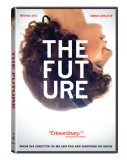A couple in their 30s decide to adopt an injured cat and have 30 days before receiving it. In that time, the burden of responsibility becomes too much and they start making drastic changes to their lives. I have reviewed enough films to realise that, unless it is a science documentary, a film title such as “The Future” can only imply a pessimistic view of it’s namesake when coming out of the “indie” film scene. This film validates such fears to a tee.
SPOILERS AHEAD. BE WARNED.
The vet explains that the cat the couple wish to adopt is expected to live only 5 months, which they like the idea of because that would mean only 5 months of their lives would be occupied with caring for this sickly animal. So instead of truly caring for the animal, they are selfishly trying to add some depth of character by appearing to be compassionate. This harsh criticism of their selfish mentalities is validated when they despair at the idea that the cat may live up to another 5 years in their care (again, according to the veterinarian they consult). Suddenly the idea of having to care for something for 5 years seems too daunting because, to them, that would be essentially eliminating the remaining years of being in their thirties.
The first thing we are introduced to in the film is the tortuous sound of a rescue shelter cat’s voice explaining it’s hopes of being adopted so that it may live out its final days in comfort. It is this, and many other stylistic elements in the film that dip into, what could be possibly viewed as supernatural elements, if they weren’t so transparently meant to exist purely as metaphoric moments of contemplation; a way for the filmmaker to demonstrate that the magic of cinema can provide such uncanny things in an earthy “realistic” story, whereas real life obviously cannot. This is certainly not an alien concept for film. In fact, many (aside from Neo-Realists) would argue is the point of cinema, to show life in ways we could not possibly see naturally. My issue is not with said stylistic elements, but the fact that this film couples these fantastic events with unnaturally quirky characters (who are often a staple in “indie” films). I become just as detached from the characters as they are with the “real world.”
Perhaps I shouldn’t be trying to explode the credibility of how “realistic” the characters are when I think I’m simply prone to irritation when it comes to characters obnoxiously creating pain and awkwardness in their life simply for the sake of doing so, then acting shocked when that same pain hurts.
Miranda July is the writer, director and star of this film. She plays a woman who is supposed to be a dancer who feels she is over-qualified for her job, yet lacks a dancer’s grace. She looks soulless when interacting with other people so it is hard to decipher any sort of motivation from her. I am ranting about this character because she is my focus of frustration at most points in this film. She makes rash, and relentlessly quirky, decisions, such as cutting her Internet to start a 30-day marathon of online dance videos (yes, it is just as logical as it sounds), and becomes so immersed in starting a whole new life (with or without her current partner) that the cat loses its life to her callousness, as she forgot to receive it on the proper date. I suddenly feel a bit too disgusted to continue much further. No, I am not simply hung up about the death of an animal, I am mortified by the manner it was used, which felt like a cheap tactic to evoke strong emotions.
Video
Widescreen 1.78:1. The picture could be a touch clearer as haze is noticeable in both light and dark scenes. Not bad, but not as polished as I’ve seen in other films of equal production quality.
Audio
Dolby Digital 5.1. A clear audio track. The music is not very abrasive, and hardly noticable at times. The dialogue is what seems to be most significant and comes through without distrotion.
English and Spanish Subtitles Available.
Special Features
Making of The Future: Less use of behind the scenes footage and more Miranda July explaining (justifying) the different elements in the film. Other lead actors have their say with regards to characters and scenes that may be seen as unusual. It was interesting to learn that this film originated from ideas lifted from a performance piece of July’s.
Deleted Scene: Amusing but also speaks to the unnatural activity of Miranda July’s character and performance.
Commentary by Miranda July: Being the Writer, Director, and Star, she does have a lot of insight into all levels of production, which is nice for information and tidbits. The trouble we run into with this feature stems from this same intense level of involvement as she seems to have little to no inner critic and borders on narcissistic as she watches her own performance and uses the word’s “I” and “me” a substantial amount of times.
Trailers: For this film and others by the same distributor.
Final Thoughts
I felt assaulted after this film. I can honestly see how some audience members might siphon some potentially meaningful messages about how time can pass by if you do not take the time to observe what is actually happening around you. Personally, I do not like seeing an animal die because of two people’s selfish behaviors. All I learned was something I already knew, do not be like these people.






